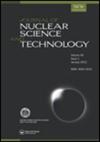核数据处理代码FRENDY版本2的开发
IF 1.7
4区 工程技术
Q2 NUCLEAR SCIENCE & TECHNOLOGY
引用次数: 0
摘要
摘要核数据处理对于连接已评估的核数据库和辐射传输代码具有重要意义。核数据处理代码FRENDY版本1于2019年发布,用于生成具有简单输入数据的ACE格式截面文件。我们发布了FRENDY版本1后,开发了中子多群截面生成、明确考虑材料中不同核素之间的共振干涉效应、背景截面自适应设置、考虑共振上散射、ACE文件扰动、概率表统计不确定性量化、ENDF-6格式文件修改等功能。FRENDY版本2发布了,包括这些新功能。它从ACE格式的截面文件或评估的核数据文件生成GENDF和MATXS格式的中子多组截面文件。本文阐述了FRENDY version 2中实现的新函数的特点,并对该代码的中子多群截面生成函数进行了验证。关键词:FRENDYnuclear data processing evaluation nuclear data library中子多群截面生成acegendfmatxs免责声明作为对作者和研究人员的服务,我们提供此版本的已接受稿件(AM)。在最终出版版本记录(VoR)之前,将对该手稿进行编辑、排版和审查。在制作和印前,可能会发现可能影响内容的错误,所有适用于期刊的法律免责声明也与这些版本有关。图1所示。传统码与FRENDY码在中子多群截面生成上的差异。显示完整尺寸图2JENDL-4.0的U-238有和没有共振上散射的截面(MT=102, XMAS 172g)。显示完整尺寸图3JENDL-4.0 (MT=102, Ein=12.5-12.8 MeV, VITAMIN-J 42g) Fe-56的二次光子光谱。显示完整尺寸图4。JENDL-4.0 (MT=22, Ein=12.5-12.8 MeV, VITAMIN-J 42g) Fe-56的二次光子光谱。显示完整尺寸图5举例说明了以1:2的比例进行能量插补的二维插补程序。显示完整尺寸图6JENDL-4.0在各分裂数(MT=22, Ein=12.5-12.8 MeV, VITAMIN-J 42g)下Fe-56的二次光子光谱比较JENDL-4.0的Fe-56, MT=22, Ein=12和13 MeV的二次光子光谱。显示完整尺寸图8。距离半径1 m的Fe-56球体中心60 cm处的中子能谱比较(JENDL-4.0, VITAMIN-B6 199g)。显示完整尺寸图9。距离半径1 m的Fe-56球体中心60 cm处的二次光子光谱比较(JENDL-4.0, VITAMIN-J 42g)。全尺寸显示本文章由计算机程序翻译,如有差异,请以英文原文为准。
Development of nuclear data processing code FRENDY version 2
ABSTRACTNuclear data processing is important to connect evaluated nuclear data libraries and radiation transport codes. The nuclear data processing code FRENDY version 1 was released in 2019 to generate ACE formatted cross section files with simple input data. After we released FRENDY version 1, many functions were developed, e.g., neutron multi-group cross section generation, explicit consideration of the resonance interference effect among different nuclides in a material, adaptive setting of the background cross sections, consideration of the resonance upscattering, ACE file perturbation, statistical uncertainty quantification of probability table, and modification of ENDF-6 formatted file. FRENDY version 2 was released including these new functions. It generates GENDF and MATXS formatted neutron multi-group cross section files from an ACE formatted cross section file or an evaluated nuclear data file. This paper explains the features of the new functions implemented in FRENDY version 2 and the verification of the neutron multigroup cross section generation function of this code.KEYWORDS: FRENDYnuclear data processingevaluated nuclear data libraryneutron multigroup cross section generationACEGENDFMATXSDisclaimerAs a service to authors and researchers we are providing this version of an accepted manuscript (AM). Copyediting, typesetting, and review of the resulting proofs will be undertaken on this manuscript before final publication of the Version of Record (VoR). During production and pre-press, errors may be discovered which could affect the content, and all legal disclaimers that apply to the journal relate to these versions also. Figure 1. Difference in the neutron multi-group cross section generation between a conventional code and FRENDY.Display full sizeFigure 2. Cross section of U-238 from JENDL-4.0 with and without resonance upscattering (MT=102, XMAS 172g).Display full sizeFigure 3. Secondary photon spectrum of Fe-56 from JENDL-4.0 (MT=102, Ein=12.5-12.8 MeV, VITAMIN-J 42g).Display full sizeFigure 4. Secondary photon spectrum of Fe-56 from JENDL-4.0 (MT=22, Ein=12.5-12.8 MeV, VITAMIN-J 42g).Display full sizeFigure 5. Example of the interpolation of energy with a ratio of 1:2 in the two-dimensional interpolation procedure.Display full sizeFigure 6. Comparison of secondary photon spectra of Fe-56 from JENDL-4.0 in each division number (MT=22, Ein=12.5-12.8 MeV, VITAMIN-J 42g)Display full sizeFigure 7. Secondary photon spectrum of Fe-56, MT=22, Ein=12 and 13 MeV from JENDL-4.0.Display full sizeFigure 8. Comparison of neutron spectra at the distance of 60 cm from the center of a 1 m radius Fe-56 sphere (JENDL-4.0, VITAMIN-B6 199g).Display full sizeFigure 9. Comparison of secondary photon spectra at the distance of 60 cm from the center of a 1 m radius Fe-56 sphere (JENDL-4.0, VITAMIN-J 42g).Display full size
求助全文
通过发布文献求助,成功后即可免费获取论文全文。
去求助
来源期刊

Journal of Nuclear Science and Technology
工程技术-核科学技术
CiteScore
2.40
自引率
16.70%
发文量
116
审稿时长
2.3 months
期刊介绍:
The Journal of Nuclear Science and Technology (JNST) publishes internationally peer-reviewed papers that contribute to the exchange of research, ideas and developments in the field of nuclear science and technology, to contribute peaceful and sustainable development of the World.
JNST ’s broad scope covers a wide range of topics within its subject category, including but are not limited to:
General Issues related to Nuclear Power Utilization: Philosophy and Ethics, Justice and Policy, International Relation, Economical and Sociological Aspects, Environmental Aspects, Education, Documentation and Database, Nuclear Non-Proliferation, Safeguard
Radiation, Accelerator and Beam Technologies: Nuclear Physics, Nuclear Reaction for Engineering, Nuclear Data Measurement and Evaluation, Integral Verification/Validation and Benchmark on Nuclear Data, Radiation Behaviors and Shielding, Radiation Physics, Radiation Detection and Measurement, Accelerator and Beam Technology, Synchrotron Radiation, Medical Reactor and Accelerator, Neutron Source, Neutron Technology
Nuclear Reactor Physics: Reactor Physics Experiments, Reactor Neutronics Design and Evaluation, Reactor Analysis, Neutron Transport Calculation, Reactor Dynamics Experiment, Nuclear Criticality Safety, Fuel Burnup and Nuclear Transmutation,
Reactor Instrumentation and Control, Human-Machine System: Reactor Instrumentation and Control System, Human Factor, Control Room and Operator Interface Design, Remote Control, Robotics, Image Processing
Thermal Hydraulics: Thermal Hydraulic Experiment and Analysis, Thermal Hydraulic Design, Thermal Hydraulics of Single/Two/Multi Phase Flow, Interactive Phenomena with Fluid, Measurement Technology...etc.
 求助内容:
求助内容: 应助结果提醒方式:
应助结果提醒方式:


